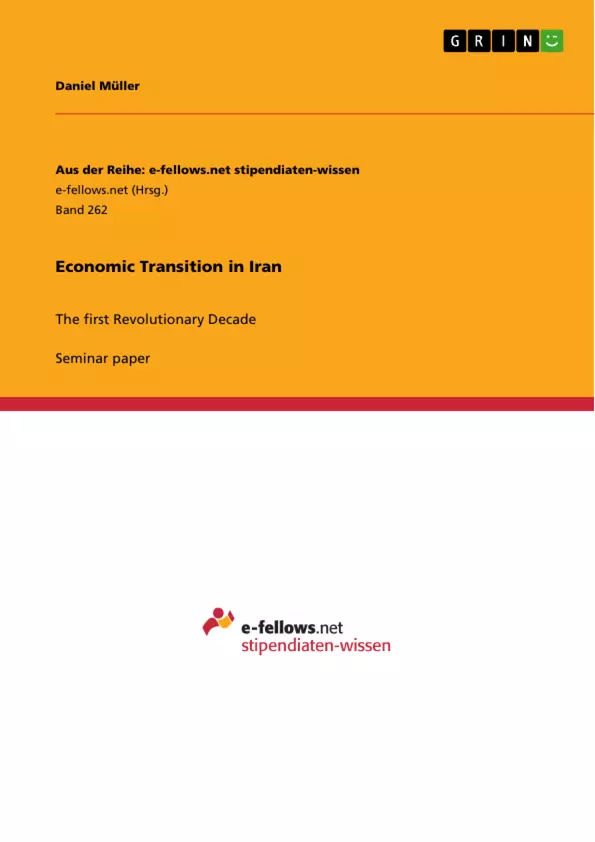The Shah of Persia is dethroned – the Islamic Republic proclaimed. A pre-eminent Western ally becomes an archenemy of the USA. In this setting, the paper focuses on the economic implications of the revolution. It deals with the underlying principles for an Islamic economy and their implications. However, the Iran-Iraq War throws a curve in an even economic development. The paper also provides an analysis of the impact of the war on the economy. The question of economic transition toward Islamic state capitalism is still on the agenda. In the wake of the Arab revolutions both present and history will present examples. The Islamic Republic of Iran is among them.
Inhaltsverzeichnis (Table of Contents)
- A) The Iranian Revolution and its Repercussions.
- B) Economic Transition – The First Revolutionary Decade
- I. The Shah's Economic Legacy...
- II. The Struggle for Sovereignty.
- III. The Iran-Iraq War.
- IV. Readjustments in the Wake of War.
- C) Facing Economic Challenges ..
- D) Charts and Tables.
- E) References
Zielsetzung und Themenschwerpunkte (Objectives and Key Themes)
This paper examines the economic policies implemented in Iran following the Iranian Revolution. It traces the entire process, from the creation of an Islamic economy, through populist policies, to economic liberalization in the 1990s.
- The economic legacy of the Shah's regime
- The impact of the Iranian Revolution on the Iranian economy
- The challenges of economic transition in the wake of the revolution
- The role of the Iran-Iraq war in shaping economic policy
- The emergence of economic liberalization in the 1990s
Zusammenfassung der Kapitel (Chapter Summaries)
A) The Iranian Revolution and its Repercussions
The establishment of the Islamic Republic of Iran following the 1979 revolution had far-reaching consequences, both domestically and internationally. The revolution resulted in a significant geopolitical shift in the Gulf area, impacting the interests of both the United States and the Soviet Union. The economic impact was equally significant, with a dramatic decline in oil production triggering a surge in global oil prices. The revolution also led to increased diplomatic isolation for Iran, culminating in a hostile relationship with neighboring Iraq under Saddam Hussein. These challenges, coupled with the constant threat of a counter-revolutionary coup, cast doubt on the Islamic Republic's ability to survive. This chapter delves into the complex political and economic landscape that unfolded after the revolution, setting the stage for the economic transition that followed.
B) Economic Transition – The First Revolutionary Decade
I. The Shah's Economic Legacy
The Shah's economic policies were characterized by a two-pronged approach. On the one hand, his adherence to Western economic principles and the adoption of cutting-edge technology resulted in impressive average annual GNP growth rates of 11% from 1963 to 1972. However, the success of these policies led to significant misallocations of resources fueled by the surge in oil revenues in 1973. The emphasis on urban industrial development at the expense of rural agricultural provinces, coupled with the promotion of exports and the influence of foreign corporations, led to uneven economic growth that benefited a limited segment of the population.
The increase in oil revenues in 1973 exacerbated these economic imbalances, leading to a period of high inflation and shortages between 1974 and 1976. Government attempts to address these problems through emergency programs, anti-profiteering campaigns, and subsidies further undermined economic prospects. Ultimately, the Iranian economy came to a standstill, culminating in deflation in 1977. The Shah's unpopularity reached its peak as workers, civil servants, and even employees of private and public banks joined strikes, further crippling the economy. The scarcity of financial means and the decline in oil production exacerbated the crisis, leaving the new regime facing a formidable set of economic challenges.
II. The Struggle for Sovereignty
The new regime inherited an economy grappling with a high deficit spending, a significant trade deficit, decreasing oil revenues, and protracted stagflation. The task of creating a new political and economic system was further complicated by internal and external pressures. While Islamic religious leaders interfered in economic policy, hostile nations, such as the United States, imposed trade boycotts on Iran. These challenges highlight the complexities of navigating the economic landscape in the wake of the revolution.
Schlüsselwörter (Keywords)
This paper examines the Iranian economy in the context of the 1979 revolution and its aftermath, focusing on key themes such as economic transition, Islamic economics, populist policies, economic liberalization, oil revenues, and the Iran-Iraq war. It also explores the legacy of the Shah's economic policies and the challenges faced by the Islamic Republic in navigating the complex geopolitical and economic landscape of the region.
- Arbeit zitieren
- Daniel Müller (Autor:in), 2010, Economic Transition in Iran, München, GRIN Verlag, https://www.grin.com/document/179552



